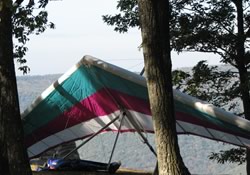If you have been flying for any length of time you have probably had to make an unexpected landing. Most of the time these emergency landings are caused by poor judgement, equipment malfunction, or weather conditions.
While it’s almost impossible for the cross-country flyer to avoid these types of landings, there are things you can do to make your journey back to the landing zone a more enjoyable one.
Look Before You Land
The best way to be prepared for the long hike is to have a survival kit along with an escape plan. The survival kit you can prepare before hand, but the escape plan will have to be made on your approach to the emergency landing zone. While flying, you should have a general idea of where the nearest road is in reference to your direction of flight just as you should know the location of the nearest emergency landing field.
Upon descent, take a look around for anything that looks like a road. Try to judge distance as well as direction. Remember that hilly terrain is further in distance that level ground. Mountainous roads maybe more difficult to recognize if they are covered in snow. Small breaks in the tree line maybe a road, a river, or a utility line that can lead you to a safe place.
In judging hiking distances in comparison to time, remember that on flat ground the average person can hike about 3 or 4 miles in an hour. In rough hilly terrain, the average lowers to about 1 or 2 miles an hour. In snow or ice, you can expect to cut these distances by half.
Immediately upon landing check your GPS or compass to try to determine the direction you will go towards the road. Once you have determined which way to you go, radio or call someone to let them know what has happened, where you are, and approximately where you are going.
Waiting for Help
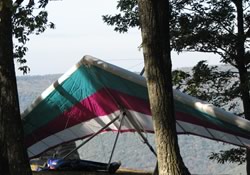
If you cannot walk to safety, sit tight and call for help. Be prepared to gather what firewood you can, breakout the emergency blanket, and prepare for an overnight stay. Make sure that you have extra batteries for your cell phone and/or your two-way radio. If your radio or phone does not transmit, you must depend on your friend or family member to call out the search and rescue team. It is most important to let someone know where you will be flying and what time you will be back.
Try to set up your camp next to a base of tree if there is one. Staying on the downwind side of the tree can protect you from wind-chill. Use your glider for protection from the wind and precipitation. Gather small debris from the undergrowth such as brush, twigs, and leaves and place them around your camp to act as a wind break and shield your fire when you start one.
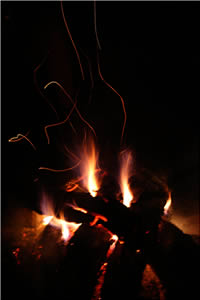
Save the use of the penlight for gathering wood during dark periods. If conditions are dry, be careful about stray sparks from the fire. Do not sleep with an active fire if conditions are dry. Remember that you are responsible for damages to landowners if you start the fire as well as damages to yourself and glider.
Try not to sit or lay down directly on the ground for any period of time. The ground may look dry, but there is almost always some moisture content that will seep through your clothing. Wet clothing will decrease your body temperature and may lead to serious health conditions such as frostbite or hypothermia. Use your thermal blanket to shield your body from the ground moisture.
If the rescuers do not know your exact location, make sure that you leave an obvious sign of your location such as your glider in the landing zone. Most search and rescue teams will use a helicopter or small aircraft to assist in the search. Make sure you break out your reserve parachute and spread it across the ground or string it between some trees. If you leave no sign to be seen from the air, you may not be seen at all.
If you have no GPS coordinates to give to your rescuers, some local 911 call centers can pin point your location by triangulation. By determining the strength of your cell phone transmission from different receiver towers, they can narrow their search area. Even if your family or friends has called 911 on your behalf, call them yourself and ask them if they can pin point your location from your cell phone transmission.
When help is on the way, keep the whistle close so that you may signal your rescuers. The sound of a whistle will carry farther than your voice. Once every half hour until you are rescued, give a loud blow on the whistle. You may get rescued sooner if there is a hunter or rancher near by. Remember that most rescue teams will not search at night so save your breath during darker hours.
Hiking Out
A three-mile walk may not seem like much, but walking out with a sprained ankle or busted knee can be the most painful experience of your life. If you did bust a button on landing, you should first evaluate your condition and see if you can make the distance. A good rule of thumb is, if it hurts a little now, it will hurt a lot later after hiking, especially if the injured part is in your legs.
If you are capable of walking out, make a slow and steady pace for the nearest road. It is better to go slow in unfamiliar terrain than to risk briskly breaking a bone in an unseen hole. If you have a choice of roads, choose the one that is down hill, even if it is further in distance. Hiking uphill will increase the amount of effort it takes to get out.
If you have more than a 1/2 mile to hike or the terrain is uneven, the hang glider pilot may wish to stow his equipment and come back later with a friend to retrieve it. One advantage of the paraglider or skydiver pilot is that the equipment is lightweight enough to carry out almost anywhere. Powered paragliders may have a more difficult time carrying their equipment back.
While leaving your equipment behind is a good idea, there is one piece of equipment you should always carry out and keep in your hands. Remember that your flight helmet is your first line of defense against wild animals or unruly dogs. Its better to crack your helmet on a wild animal that get your leg cracked by a biting bear.
Before beginning your escape, make sure that you have enough sunlight remaining to cover the distance to the nearest road. Walking along a road at night can be easily done but walking through the woods after dark will most certainly cause injury. If you do find yourself without enough light to see the ground in front of you, hold up and camp. The narrow light beam from your penlight will not be enough to navigate. Save the penlight for gathering firewood and setting up camp. Moonlight is not adequate to avoid stepping in a hole or tripping over a tree root.
If you use a GPS as part of your equipment, it may not be enough to get you to safety. Batteries die and the GPS maybe damaged while landing. Carry a compass to assist you in your directions if your GPS becomes unusable. Keep in mind that mountains may contain iron which changes the directional point of the compass.
In rough terrain, hiking in a straight line can be difficult. Obstacles such as thick undergrowth and hills will most certainly force you to go around. Try and estimate where you should be on the other side of the obstacle before you go around it and head for that point. Once at that point, resume your compass direction. If the distance around the obstacle is far, you may have to trek across or through the obstacle.
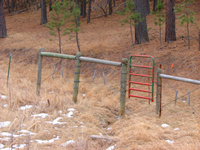
There maybe times when you just lose your bearings and forget which way to go. If you do find yourself in this situation you should look for a drainage gully and follow it downhill. Gullies usually turns into stream and streams are a popular place for recreational parks and residential homes. Streams will often lead you to a road.
If you happen to come across a fence while lost, stay with it. Fences usually lead to civilization and rescue. It is a good idea to stay close to the fence rather than wandering out into the middle. Keep in mind that bulls and horses are known for charging. When following a fence you have a 50/50 chance of going the shortest route to help. Eventually you should come across a gate with a road or path leading away.
Remember that in winter time, you body is burning carbohydrates at a faster rate to warm itself. Eating the trail mix or candy bars before you hike will prepare your body with the extra energy it needs to heat itself. Since up to 40% of body heat is lost through the top of the head, you should wear an insulated hat to preserve your body’s temperature.
In remote areas you will almost always come across streams. If the stream is over ankle-deep and there are no dry crossings, you will need to remove your boots, roll up your pants, and barefoot across. If you do walk across in your boots or shoes, be prepared for an uncomfortable walk. The only thing worse than walking in wet boots or shoes is having to hike with dog crap between your toes.
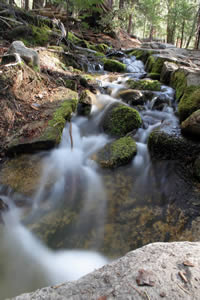
After crossing, warm and dry your feet as quickly as you can with your hands and put back on the dry socks. Remember to never cross a stream in the winter that will get any of your clothes wet. Wet clothes will lead to frostbite or hypothermia.
Drinking from a stream should only be done as a last resort. Microscopic organisms live in most streams and will make you sick. If you must drink, drink small portions. If you know that you have only a two to three-hour hike ahead, it would be best to avoid drinking and tough it out. Streams that are fast running and shallow are usually better to drink from than those that are deep and slow.
Make sure that you have an extra pair of socks in your survival kit. Before beginning your hike, you should turn your socks inside-out and place them next to your skin to keep them as warm as possible. Having an extra pair of dry warm socks can be a toe saver.
While hiking in cold weather you will most certainly break into a sweat. Remove layers of clothing as required to keep your body temperature comfortable. During the hike, it maybe necessary to remove and replace layers of clothing several times, especially if the terrain is a combination of hills and level land. Be cautious to not expose any wet skin in cold windy conditions. If hiking in the winter, keep your face dry as possible by removing sweat that forms across the brow and forehead with your gloves. Forehead sweat will not be enough to penetrate your gloves and cause damage to your hands.
For those that have little or no experience in trekking, you should take special notice to what your body is saying. Keep walking until you become winded or your muscles ache. A hiker that takes breaks will go further than a hiker that pushes his body to the point of break. Usually, a ten minute break every 45 minutes or hour will be adequate. If climbing in mountains or hilly terrain, it may be necessary to take a break several times during a short period of time to top the summits. When going down the mountain, the chance of slipping on small rocks and wet leaves is possible. Take it slow and easy on the downhill. A good hiking boot with a jagged tread will make the hills easier. If conditions are snowy or icy, try to avoid mountains altogether.
Getting Help

Once you have reached a road hopefully someone will see you and render assistance. This would be great, but don’t count on it. When a car is approaching the last thing you want to do is stick a thumb up. Most people don’t pick up hitch hikers. If you see an approaching car make sure that you are stand on the shoulder and not in the middle of the road. Put you hands over your head and wave them up and down from your head to your hips. The waving of the hands along with jumping up and down will give them the impressions that you need help. Don’t expect a ride if a car slows down and don’t try to get in. If you show any aggressive actions, they may just drive off. Stay where you are and calmly tell them you need help. Don’t ask them to call a family member or friend as this request will most likely get ignored. Most people will gladly call the police or an ambulance for you. If they see you are non aggressive and are sincere in your request for help, they may offer you a ride.
If there are no cars on the road and you happen to come across a house after dark, it may be risky to approach the house. If the lights are out it probably means the people are not home or are asleep. Don’t go near the house as you may get shot. If there are lights on and it is not too late, knock on the door and ask them if they can make a call for you. Do not ask to come in and use the phone. If they see you are non aggressive and you explain your situation well, they may invite you in. If they do nothing but look at you through the window, ask them to call the police or an ambulance and walk away. Do not wait in the yard. Walk back to road and wait there. If somebody doesn’t show up in 30 minutes, keep walking. Eventually someone will assist you.
Always keep in mind that in rural areas, most homes will have a shotgun or a hunting rifle. If they don’t want to help, walk away and consider yourself lucky.

One thing to remember is to not be afraid of getting help from professional services. Firemen, police, and ambulance personnel are all trained to get render first aid. Getting help form the police or ambulance will get you to your family the quickest. If the weather is cold and your hike was long, it would be a good idea to check yourself into a hospital and get the doctors to check you for hypothermia and frostbite. If you wait too long to treat frostbite you could lose a toe or finger.
Keep in mind, that hypothermia will cause decreased mental capacity. What you think may only be a minor injury could be something that needs professional treatment. Seek a second opinion from family, friends, or professional services.
Man’s Best Friend, Trekkie’s Worse Nemeses
Most rural homes will have dogs. Most rural counties do not have leash laws. If you are approaching a house at night that has a dog, turn around and go the other way. Dogs will be very aggressive at night. To know if there are any dogs at a house, give a loud whelp while standing on the road. If there are dogs, you will know it in a few seconds. Be prepared to defend yourself with your helmet.
During daylight hours, a good rule is to carry a handful of rocks in case you are approached by a dog. Most dogs will keep their distance if you throw a rock in its direction. Do not hit the dog with the rock unless it is within kicking distance. Raising your voice in a low pitch will help keep the dog at bay. The dog knows when you are not looking. Turning your back on a growling dog will cause it to advance. Always keep an eye on the dog even when you are walking away.

If the dog you come across is a pit bull, your chances of being attacked are greater, in fact, there is a very good chance that you will get bitten. Remember that a pit bull will try to knock you down and go for your throat. When a pit bull is charging keep your hands high out of its reach. Do not put your hands out to try to protect yourself. Give it no other choice but to go for your lower extremities. While it is going for your lower extremities, take an aggressive swing with your helmet to its head. A swift kick to the body will help repel the dog. Repeat as necessary. If it does knock you over, get up quick. The key to defending against a pit bull and other aggressive dogs is to keep your arms free for swinging your helmet while remaining on your feet.
Lastly, always remember that these vicious animals are somebody’s pet whom are loved and cared for by their owners. If you injure or kill somebody’s pet, you can expect some kind of repercussion from the owners. Make sure that you defend yourself in public right-of-way or public easement on the road. Most roadways have a minimum of 15′ right-of-way or easement from the centerline of the road on each side. Staying within 15 feet of the centerline should keep you out of legal trouble. Injuring or killing a pet in self-defense on private property may result in your arrest because you could be accused of trespassing in the first place.
Have Fun and be Safe
Hopefully these survival tips will never be used, but if you ever get yourself into an isolated landing field, you should know how to take care of yourself and get yourself out of this worst case scenario. The key to fun flying in the winter is to dress warm and be prepared for the worse. The additional weight of an emergency kit outweighs not having one. Good flying.

